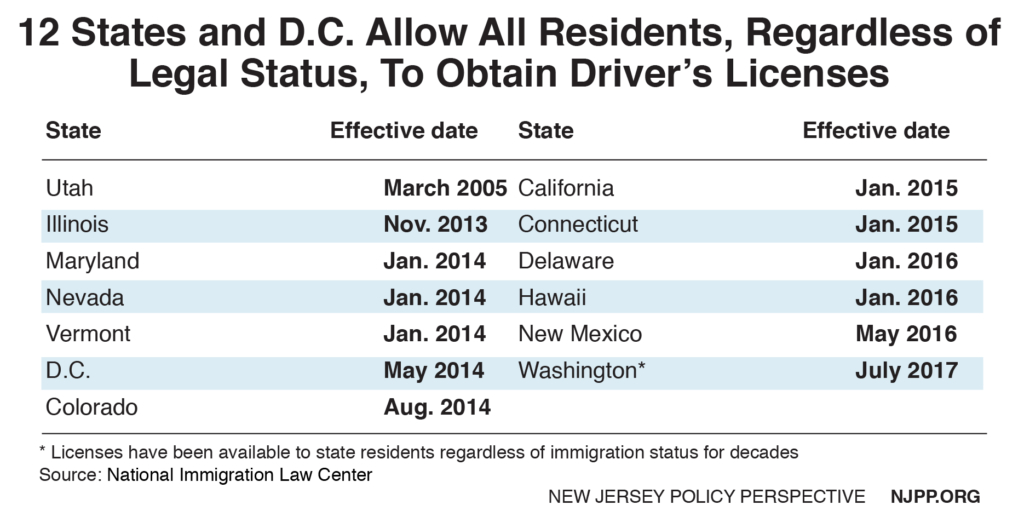To read a PDF version of this report, click here.
As New Jersey prepares to welcome a new administration and legislature, it is poised to become the 13th state to allow all its residents to apply for driver’s licenses, regardless of their immigration status. Doing so would increase public safety, help the state’s economy and increase the well-being of all families – particularly the hundreds of thousands who would be newly allowed to drive legally.
In total, about 466,000 New Jersey undocumented immigrants are of driving age and would be eligible for a license.Based on the experience of other states, we estimate that half these eligible New Jerseyans – 233,000 in all – would receive a license within the first three years of implementation,[1] a 3.8 percent increase in the total number of licensed drivers in the state. (A higher number would likely apply for a license but not everyone who applies passes the written and road tests and is ultimately licensed.)
 Nine New Jersey counties would see 10,000 or more residents sign up for licenses, while an additional four counties – Atlantic, Camden, Ocean and Somerset – would see between 5,000 and 10,000 sign up.
Nine New Jersey counties would see 10,000 or more residents sign up for licenses, while an additional four counties – Atlantic, Camden, Ocean and Somerset – would see between 5,000 and 10,000 sign up.
Allowing all New Jerseyans who can prove their identity and in-state residence to be trained, licensed, and insured would make the state safer, help the state’s economy and increase the wellbeing of families.
Make the state safer
- Having more licensed drivers would make New Jersey’s roads safer, because more people who can be accountable for their driving record.
- Undocumented immigrants are already careful drivers – but new research finds that they are even more careful in states that allow them to drive legally.[2]
- Once licensed, undocumented immigrants are less likely to flee the scene of an accident. In California, for example, allowing all residents to drive regardless of status led to a significant decline in hit-and-run accidents. The researchers at Stanford University who published these findings suggest that licensed undocumented drivers have weaker incentives to flee because they are less likely to fear deportation.[3]
- There would also likely be an overall decrease in fatal accidents, based on the experience of the three states with the longest-standing policies similar to the one being proposed in New Jersey.[4]
- Towns and cities across the state would safer as the trust between immigrant communities and law enforcement improves.
Help New Jersey’s economy & boost the collection of motorist fees
- New Jersey’s economy works best when everyone can work and provide for themselves and their families. In many parts of the state, having a car and ability to drive safely is central to achieving that goal. By allowing more people to legally drive, this policy would help more New Jerseyans participate in the state’s economy and contribute more to their local economies.
- Since auto insurance is compulsory in New Jersey, thousands of drivers would obtain coverage, boosting annual premium payments by about $223 million a year.[5]
- The state would likely collect $11.7 million in license fees (assuming 233,000 people sign up for a license that costs $50). On top of these initial license fees, New Jersey would likely collect these fees on a recurring basis when licenses expire every four years – and it would also likely collect $2.3 million in one-time fees for driving permits, since the 233,000 would be required to get permits because they are first time license holders.
- These newly-licensed drivers would purchase an estimated 84,000 automobiles, boosting vehicle registration fees by $3.9 milion (assuming that newly purchased cars will be registered at a cost of $46.50 per registration).[6]
Increase the well-being of families
- More parents would be able to drive their children to school or doctors’ appointments without breaking the law.
- This policy would reduce the chances of family separation via deportation or jail time and help ease the anxiety that can damage a child’s development.
- Other New Jerseyans who have trouble obtaining the required documentation under the current 6-point system would be able to validate their identity and New Jersey residence under this new policy.
Endnotes
[1] NJPP calculated the number of potential new undocumented license holders by taking the undocumented driving age population (16 years and older) from the Migration Policy Institute database and using the take up rate (50 percent) of Illinois, which is in the high end and has a similar undocumented population to New Jersey’s. To see further explanation on the “take up rate” see Fiscal Policy Institute, Expanding Access to Driver’s Licenses: Getting a License Without Regard to Immigration Status, January 2017 (http://fiscalpolicy.org/wp-content/uploads/2017/01/FINAL-Drivers-licenses-report-2017.pdf)
[2] Latino Policy Institute at Roger Williams University, A Legal and Policy Analysis of Driver’s Licenses for Undocumented Rhode Islanders, June 2016. http://www.rifuture.org/wp-content/uploads/drivers-license_report-legal.pdf
[3] Hans Lueders, Jens Hainmueller and Duncan Lawrence in Proceedings of the National Academy of Sciences of the United States of America, Providing driver’s licenses to unauthorized immigrants in California improves traffic safety, April 2017. http://www.pnas.org/content/114/16/4111.full.pdf
[4] New Jersey Policy Perspective, Share the Road: Allowing Eligible Undocumented Residents Access to Driver’s Licenses Makes Sense for New Jersey, September 2014. https://www.njpp.org/reports/share-the-road-allowing-eligible-undocumented-residents-access-to-drivers-licenses-makes-sense-for-new-jersey
[5] NJPP calculated the potential premium payments of new license holders by multiplying the average auto insurance expenditure (http://www.naic.org/prod_serv/AUT-PB-13_2016.pdf) in 2014 and the number of potential new license holder who would buy insurance, using Utah’s take-up rate of 76 percent as a baseline.
[6] NJPP analysis using New York state estimates of new licenses and automobile purchases in two reports by Fiscal Policy Institute reports: Expanding Access to Driver’s Licenses: Getting a License Without Regard to Immigration Status, January 2017 (http://fiscalpolicy.org/wp-content/uploads/2017/01/FINAL-Drivers-licenses-report-2017.pdf) and Expanding Access to Driver’s Licenses: How Many Additional Cars Might Be Purchased?, January 2017 (http://fiscalpolicy.org/wp-content/uploads/2017/01/FPI-Additional-cars-report-2017.pdf)


